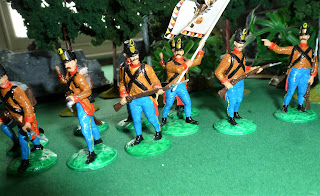In the closing weeks of last year Anthony and I decided to take his 54mm Battle of Metauro game for another spin, originally this was a board game made in Spain by Rojas y Malaret, Anthony took the original board and had it blown up as a gaming mat for 54mm toy soldiers, here's how the game works: (click on the images to enlarge them)
With the German (Hausser) version of the game you could purchase additional extension packs to increase both the number of figures on the board and also the variety of troop types, such as archers, light infantry and Gallic allies. Accordingly, Anthony has been building up his collection of DSG Roman and Carthaginian forces in line with the expansion packs available for the original game.
The game opens with troops being placed on the squares with coloured triangles (each individual figure represents a unit), each square can contain 3 infantry, 1 infantry and 1 cavalry, 2 cavalry or 1 elephant. You can have less figures on a square but you can't exceed these numbers per square, this can have an important impact on movement and combat later in the game.
Movement distances are 1 square for infantry, 2 for elephants and 3 for cavalry. Woods and ruins provide cover and can only be entered by infantry. Squares with rocks are an obstacle, they can't be entered or passed over by any troop types. Infantry in cover get a bonus in combat.
A unit moving into a square adjacent to a enemy must attack, combat takes place between individual units and the attacking player decides the order of combat, both sides roll a D6 to decide the outcome. Highest score wins, 1, 2 or 3 have no effect, 4 or 5 cause the loser to retreat 1 square (2 squares for elephants), 6 is a kill and the losing unit is removed from he board. If both sides get the same score (including bonus modifiers, see below) there is no effect. A unit can only take part in combat once in each move turn.
There is no bonus for the attacker but infantry in cover get a +1 added to their score. Cavalry always get a +1 in combat while elephants get a +2. Only the Carthaginians have elephants (obviously) but to even things up the Romans get 3 designated figures who can attack and force the elephants to retire.
Rivers can only be crossed at the fords indicated by stones, the central rocky plateau (shown here in orange) counts as cover for infantry, the rocks on three sides around it are impassable.
After combat, a losing unit forced to retire must move into the square directly behind it (elephants retire 2 squares), subject to that square being accessible to the retreating unit type and having enough space to accommodate them i.e. a cavalry unit can't retire into woods or into a square containing 3 infantry, 2 cavalry or 1 elephant, but can retire if the square is empty, has 1 infantry or 1 cavalry on it already. If the losing unit cannot retire onto the square behind, it is destroyed. This can be particularly problematic with elephants, you need to keep plenty of retiring space clear behind them!
After each individual unit combat, if one unit is destroyed or forced to retire, the the victorious unit can choose to occupy the vanquished enemies place on his square.
E.g. 3 Roman infantry move up to an enemy square containing 1 infantry and 1 cavalry. The Roman commander chooses one of his infantry to attack the Carthaginian infantryman, the dice scores are 4 against 3 so the enemy infantryman is forced to retire and the victorious Roman moves into his square, beside the Carthaginian cavalryman. Next he chooses the second infantryman to attack the Carthaginian cavalryman, the dice scores are 4 against 5 but the cavalryman has a +1 making 6 so the attacking infantry unit is destroyed and removed, but the victorious Carthaginian decides to stay where he is and not occupy the Roman infantryman's square. Finally the Roman commander uses his third infantryman to again attack the Carthaginian cavalryman, who can't fight back because he has already been in combat this turn, the Roman throws D4 forcing the cavalryman to retire and moves into his square.
At the end of this move turn this leaves the 2 Roman infantry in the square adjacent to the Carthaginian infantry and cavalrymen who have been forced to retire. It is now the Carthaginian move turn and they must attack the 2 Roman infantry units in the adjacent square, both side are effectively pinned. If the victorious Roman units had not advanced into the vacated square during the last round of combat described above there would have been a gap between both sides and the Carthaginian units would have been free to redeploy.
The game is won by killing your opponent's General or occupying both of the camp squares on their baseline.
Simple, quick play rules, easy to learn but with subtleties that can cause a few unpleasant surprises, the game system is very well suited for use with 54mm toy soldiers and increasing the number of units in play adds greatly to both the visual impact and tactical opportunities.
In our previous game we tended to try and occupy the areas of cover which dominate the centre of the board in order to acquire the +1 combat bonus for infantry and it became a bit of a slugfest there with the mounted units dancing around on the periphery. In the game pictured above the Carthaginians allowed the Roman infantry to occupy the ruins in strength and left cavalry units hovering around to block any attempted breakout, effectively turning the ruins into a POW camp.












